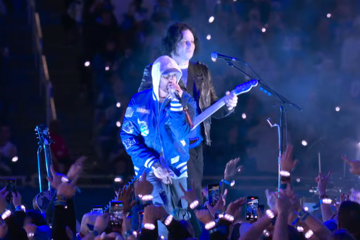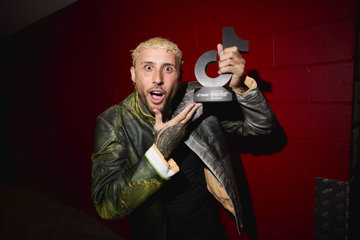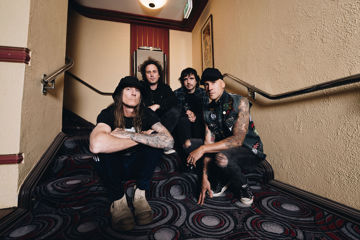The 'Her Sound, Her Story' Creators On Why 'It’s Like Magic' When Women Join Forces
"...if there’s ever moments I forget why we’re doing this that’s my reference point. It’s so beautiful when women come together, it’s like magic."
Australia! For the first time in who knows how long I’m feeling pretty damn proud we got it right (well, 61.6% of us anyway...)!
Were we a little late? Hell yes. Should it have been up for public debate in the first place? Hell no. But let’s revel in the fact that more than half the country believes in equality! Well, marriage equality anyway. I’m by no means putting a negative spin on this, I couldn’t be happier about the step in the right direction but I suppose I’m just mindful that the journey is long... None the less, YES! Love is love and we all deserve the same equal rights in marriage and opportunity in all walks of life.
This week I chatted to two of the most creatively intriguing women I know. Michelle Grace Hunder and Claudia Sangiorgi Dalimore, the creators of Her Sound, Her Story who took the time to talk to me about gender equality in the creative industries before their (now sold out!) documentary screening next week.
Hunder begins “There’s so much conversation about gender inequality… there’s no long form conversations. There are articles and statistics but no one is asking these women ‘How do you feel about these issues? Is it even an issue? Do you want to continue talking about this? What obstacles are you facing?’ We want to create a conversation around that with this project.”
Don't miss a beat with our FREE daily newsletter
Let me put a little disclaimer in here: as a male, I don’t claim to understand what it must be like to be a woman in this industry, nor the difficulties that may present. But I’m trying to understand these issues to better myself and I strongly urge you to do the same.
After asking Hunder about her previous project Rise (a photography book of Australian hip hop artists) she goes on to tell me that “out of the 182 artists I shot for Rise, 10 of them were female… and the conversation around gender disparity kept coming up in the media. I wanted to explore why that is and I thought that photography wouldn’t do the whole issue justice. We wanted to sit with these women and actually talk about it.”
So what can we be doing to address this topic? I don’t think there’s a silver bullet for this issue, but I think there are some simple techniques, behaviours and attitudes we can change within ourselves.
Dalimore responds “The way a male hears information can be different to how women hear information… it can be fundamental miscommunication, or just unconscious things happening so there needs to be some calling out and that can be done in a positive way. ‘Please don’t say that, don’t treat her like that, have you looked for a woman for this role?’ These subtleties change and infiltrate the top tiers of power which will start to shift things below.”
“There’s an unconscious bias,” Hunder adds. “Festivals that are organised by men might just be putting on bands they like. It may not be intentional to exclude women, but by broadening the scope of who you and your mates love, there’s a whole world of incredible artists that include women and people of colour and people from the LGBTQI community. All that means is the fans get to hear a broader, more diverse and beautiful landscape of Australian music. It’s really important to keep pushing that.”
When you think about sitting down with 60 of the biggest female artists in Australian music, do you think there might be similar issues raised? Personally I can imagine inequality, sexism, ageism and harassment (the list goes on) must be a frequent topic among these women and for me to imagine that implies I’m already aware of it. This is why it’s so important to actively push against these flaws in our industry.
“There have been so many moments in the last few years when I realised I’m just like them (other female artists)” comments Dalimore. “Where some males that we worked with or encountered along the way, suggested ‘shaving a little bit off’ or chopped and changed what we were doing... It makes you second guess yourself and as a women, you just give away power without even knowing it.”
Another brilliant example Hunder illustrates to me is that “as women get older, they start to become unapologetic because they really ‘come into their own’ through their experience. But that’s also at the same time the industry tells them they’re redundant. So you have this really interesting dichotomy of creating your best art, when the industry doesn’t want to hear from you anymore…”
I ask just how these women connect to the project, to the artists, their stories and how they’re able to invest so much love, passion and straight up hard work into such an insightful project. Dalimore responds “I can still feel it. To keep going with this documentary, the inspiration comes from when the women were all together. That feeling of community and solidarity… in Western culture, we’re quite separated and insular in our existence. So that state when we were together, if there’s ever moments I forget why we’re doing this that’s my reference point. It’s so beautiful when women come together, it’s like magic.”
Check out the full interview below, shot by TRILLION, and while you may have missed the preview screening for the documentary Her Sound, Her Story, you can check out the vignettes at www.hersoundherstory.com and will no doubt have an opportunity to see it in full soon!







